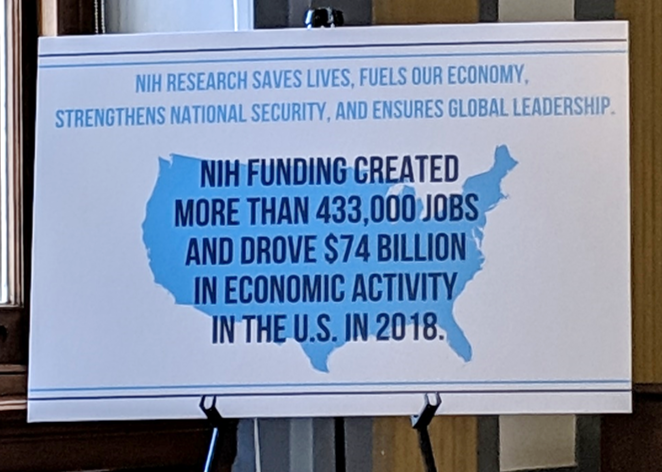Cure one, cure them all – The NIH BRAIN initiative

On July 24, 2019, the Senate NIH Caucus sponsored a briefing on the NIH BRAIN Initiative, showcasing just one of the many areas in which the NIH is leading cutting-edge research efforts to improve human health. The BRAIN Initiative was established in 2013 with the goal of developing innovative new technologies and applying them to better understand how the brain works, and ultimately, how we can treat, cure and prevent brain diseases and disorders. The briefing was moderated by Debbie Forrest, President of the ACT for NIH Foundation.
Senator Richard Durbin of Illinois and Senator Lindsey Graham of South Carolina, Co-Chairs of the Senate NIH Caucus, both expressed their support for NIH funding, and applauded the important work that the NIH does to understand complex diseases, to find cures, and to improve lives.
Walter Koroshetz, MD, Director of the National Institute of Neurological Disorders and Stroke, spoke about the extraordinary complexity of the human brain, which he described as the most amazing information processing device known to man. A variety of diseases, from developmental disorders to depression, occur because circuits in the brain are not functioning or are not connected correctly. Dr. Koroshetz highlighted some of the research that has been funded by the BRAIN Initiative to better understand brain circuitry. He particularly focused on the development of new imaging techniques that can be used to visualize the activity of the neurons that make up these circuits. As an example of a clinical application of this research, he described a project from the University of California San Francisco to study the brain activity of patients as they are speaking. Researchers were able to develop a brain-computer interface that translates the electrical activity of the brain during speech, creating a synthesized voice that is indistinguishable from a real human voice. Such technology could allow patients with a speech or communication disorder to speak through a computer without the need to move their mouth.
Andrea Beckel-Mitchener, MD, Director of the Office for Disparities Research and Workforce Diversity at the National Institute of Mental Health, serves as the “Cells and Circuits” team lead for the NIH BRAIN Initiative. She described the efforts of the Brain Initiative Cell Census Network (BICCN). There are 86 billion neurons in the human brain, as well as many other types of brain cells. Projects in the BICCN aim to identify these cells and characterize where they are and how they fit together. The goal, Dr. Beckel-Mitchener described, is to create a “Google map for your brain,” so that at any location you can pinpoint the cell type and have access to layers of information, from what is going on at a molecular level, to what is occurring in 3D anatomical space. Such a resource would be invaluable in both characterizing a healthy brain, and in understanding what is going on in different diseases and disorders. Dr. Beckel-Mithchener emphasized the importance of the ‘4 c’s’: creativity, communication, collaboration and coordination in this endeavor, as multiple scientific partners work together to create this integrative resource.
Christopher Cowan, PhD, is the chair of the Department of Neuroscience at the Medical College of South Carolina. One aspect of his research focuses on relapse, which is often triggered by people, places, objects, or emotional states that recovering addicts associate with drug use. As it turns out, these long-lasting associations could potentially be encoded in our brains at the molecular level. Our DNA provides an instruction manual for how a cell is built, but not all of the DNA within a particular cell is ‘expressed’– i.e. read and carried out. The regulation of DNA expression is very complex, and depends in part on how tightly our DNA is bundled into condensed structures, called chromatin within the nucleus of our cells. Intriguingly, the use of addictive drugs changes the chromatin structure in our brain cells, particularly in a region of the brain called the nucleus accumbens. To study this, Dr. Cowan’s group used a rodent model of addiction that mimics relapse in response to environmental triggers such as light and sound. By genetically manipulating specialized proteins or enzymes in the rodents that in turn regulate chromatin bundling, they were able to reduce drug-seeking relapse behavior. As Dr. Cowan concluded, this finding suggests that in the future, we could potentially develop therapeutics that would help prevent relapse in patients with addiction.
Brian Wallach, JD, is the Founder of I am ALS, a patient-led, patient-centered community. Mr. Wallach has a long career in policy and law, and in 2017, was himself diagnosed with ALS. He began by asking panelists and audience members a question– how can we work with you to truly speed the fight against neurological diseases and thereby save tens of millions of lives? He also asked people whether they knew someone with ALS. Mr. Wallach revealed that in a public poll conducted by I am ALS, the majority of Americans knew little to nothing about the disease. Over 60% of Americans did not know that ALS is always fatal. He also emphasized that ALS shares many similarities with other diseases, including Parkinsons, Alzheimer’s, and Huntington’s disease. This means that scientific breakthroughs for one disease could have tremendous impacts for the other diseases, or as Mr. Wallach put it, “cure one, cure them all”. Noting that 1 in 15 Americans will be diagnosed with a neurological disease, he ended with emphasizing the urgency of funding scientific research and of moving science forward into cures and treatments that can save lives.
This blog post was written by Rebecca Mandt, a policy intern at Research!America. The policy internship is supported by the Burroughs Wellcome Fund.




